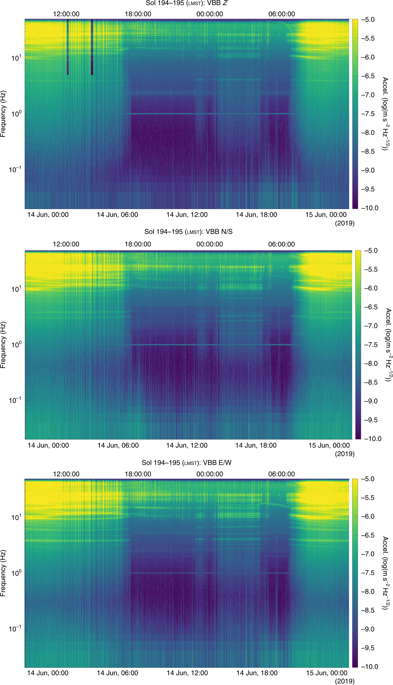Nature Geoscience ( IF 15.7 ) Pub Date : 2020-02-24 , DOI: 10.1038/s41561-020-0536-y P. Lognonné , W. B. Banerdt , W. T. Pike , D. Giardini , U. Christensen , R. F. Garcia , T. Kawamura , S. Kedar , B. Knapmeyer-Endrun , L. Margerin , F. Nimmo , M. Panning , B. Tauzin , J.-R. Scholz , D. Antonangeli , S. Barkaoui , E. Beucler , F. Bissig , N. Brinkman , M. Calvet , S. Ceylan , C. Charalambous , P. Davis , M. van Driel , M. Drilleau , L. Fayon , R. Joshi , B. Kenda , A. Khan , M. Knapmeyer , V. Lekic , J. McClean , D. Mimoun , N. Murdoch , L. Pan , C. Perrin , B. Pinot , L. Pou , S. Menina , S. Rodriguez , C. Schmelzbach , N. Schmerr , D. Sollberger , A. Spiga , S. Stähler , A. Stott , E. Stutzmann , S. Tharimena , R. Widmer-Schnidrig , F. Andersson , V. Ansan , C. Beghein , M. Böse , E. Bozdag , J. Clinton , I. Daubar , P. Delage , N. Fuji , M. Golombek , M. Grott , A. Horleston , K. Hurst , J. Irving , A. Jacob , J. Knollenberg , S. Krasner , C. Krause , R. Lorenz , C. Michaut , R. Myhill , T. Nissen-Meyer , J. ten Pierick , A.-C. Plesa , C. Quantin-Nataf , J. Robertsson , L. Rochas , M. Schimmel , S. Smrekar , T. Spohn , N. Teanby , J. Tromp , J. Vallade , N. Verdier , C. Vrettos , R. Weber , D. Banfield , E. Barrett , M. Bierwirth , S. Calcutt , N. Compaire , C.L. Johnson , D. Mance , F. Euchner , L. Kerjean , G. Mainsant , A. Mocquet , J. A Rodriguez Manfredi , G. Pont , P. Laudet , T. Nebut , S. de Raucourt , O. Robert , C. T. Russell , A. Sylvestre-Baron , S. Tillier , T. Warren , M. Wieczorek , C. Yana , P. Zweifel

|
Mars’s seismic activity and noise have been monitored since January 2019 by the seismometer of the InSight (Interior Exploration using Seismic Investigations, Geodesy and Heat Transport) lander. At night, Mars is extremely quiet; seismic noise is about 500 times lower than Earth’s microseismic noise at periods between 4 s and 30 s. The recorded seismic noise increases during the day due to ground deformations induced by convective atmospheric vortices and ground-transferred wind-generated lander noise. Here we constrain properties of the crust beneath InSight, using signals from atmospheric vortices and from the hammering of InSight’s Heat Flow and Physical Properties (HP3) instrument, as well as the three largest Marsquakes detected as of September 2019. From receiver function analysis, we infer that the uppermost 8–11 km of the crust is highly altered and/or fractured. We measure the crustal diffusivity and intrinsic attenuation using multiscattering analysis and find that seismic attenuation is about three times larger than on the Moon, which suggests that the crust contains small amounts of volatiles.
中文翻译:

InSight地震数据对火星浅层弹性和无弹性结构的约束
自2019年1月以来,InSight(使用地震调查,大地测量学和热传输的内部勘探)着陆器的地震仪对火星的地震活动和噪声进行了监测。晚上,火星非常安静。在4到30 s的时间间隔内,地震噪声比地球的微地震噪声低约500倍。由于对流大气涡旋引起的地面变形和地面传递的风力着陆器噪声,白天记录的地震噪声会增加。在这里,我们使用大气涡旋以及InSight的热流和物理特性的锤击信号来约束InSight下的地壳属性(HP 3)仪器,以及截至2019年9月检测到的三个最大的地震。从接收器功能分析中,我们推断出最高的8-11 km地壳高度变化和/或破裂。我们使用多散射分析法测量了地壳的扩散率和本征衰减,发现地震衰减约为月球的三倍,这表明地壳中含有少量挥发物。











































 京公网安备 11010802027423号
京公网安备 11010802027423号